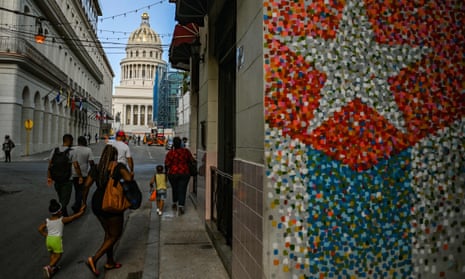One morning last spring, 22-year-old Ernesto Hernández set out from the outskirts of Havana on a rickety boat hoping to cross the Florida Straits. The plan was to leave behind a dilapidating communist-ruled island in which he saw no future, and sail into an American dream.
Nobody has heard from him, or the other six people onboard, since.
“We all know he drowned,” said Camilo Soria, 22, a childhood friend. “I heard adults talking about things like this when I was a kid, but you don’t really know what it means until you lose somebody.”
The number of Cubans leaving the island will reach an all-time high this year, analysts predict. The US Coast Guard has intercepted nearly 2,000 Cubans since October. But far more are flying to the Latin American mainland before journeying up to the US-Mexico border: 114,000 have crossed into the US since October, according to US Customs and Border Protection – 1% of the island’s entire population).
Following a crackdown on protesters who flooded the island’s streets in unprecedented numbers last summer, some Cubans are emigrating for political reasons. But with the island’s economy mired in a deep crisis with no end in sight, the vast majority are leaving for a better life.
Soria, who is studying sports science at the University of Havana, says he knows about 40 people – friends, classmates, neighbours – who have left in recent years.
Does he want to leave too? “Yes, of course,” he answered in a recent phone interview, before revealing he was standing in line outside the Mexican embassy in Havana, trying to get his papers in order.
Trump’s “maximum pressure” policy towards Cuba, mostly left in place by the Biden administration, succeeded in driving down people’s living standards. The pandemic was the last straw: for two years now, standing for hours in line for basic goods like chicken has become a dreary new normal.
And for now at least, the stars have aligned for those who want to leave.
“If you can get to the US border you are going to get in,” said Andrew Selee, the president of the Migration Policy Institute, a Washington thinktank.
As US-Cuban relations have soured, cooperation on migration has broken down. Since the Trump administration shuttered consular services at the US embassy in Havana 2017 after diplomats reported mysterious health incidents, legal migration to the US has been largely shut off: Washington has an accord with the island to issue an annual 20,000 migratory visas, but has issued barely any.
Meanwhile, Cuba has stopped accepting flights carrying “excludables” from the US, leaving the Biden administration with no way to deport. “That’s the primary deterrence the US has for people who cross unauthorized,” said Selee. “They don’t have that at the moment.”
The journey for Cuban migrants, while still treacherous, has also become more viable.
Historically, people tried to cross the 90-mile strait by sea using rafts, hijacked ferries or even floating pickup trucks. Legal avenues to leave were scant; government inspectors would make an inventory of people’s possessions – even counting up the cutlery – before granting exit visas.
But these days the Communist party has eased travel restrictions, and the primary problem has switched from getting a visa to leave the island, to getting a visa for another country.
That changed last November when Daniel Ortega’s government allowed Cubans to travel visa-free to Nicaragua (seemingly to create a bargaining chip with the US while the ruling clique negotiates for sanctions relief). This has created a land bridge to the US for wealthier Cubans – those with a car or a house to sell, or with family on the outside. They can now buy a $4,000 one-way ticket to Managua and then make their way overland to the southern border.
Rather than sneak across, Cubans tend to approach immigration officials to claim asylum. With border crossings from all nationalities into the US are on course to break all records this year, authorities are overwhelmed, which has added to the backlog in asylum cases.

“That’s an enormous advantage for Cubans,” said William LeoGrande, professor of government at American University. “Because once they are in, the clock starts to run … If they are in the US for a year and a day they become eligible to request permanent residence – a privilege that no [other] nationality has.”
Rafael Hernández, editor of the state-linked social science journal Temas, said obtaining US permanent residence under the Cuban Adjustment Act is simple.
“It’s like taking out a wisdom tooth – just something you have to go through,” he said.
But the journey is by no means without risk: experts say Cubans are among the nationalities most likely to get kidnapped when nearing the Mexican side of the border. Criminal groups know that they will have paid thousands to get this close, and most likely have family in the US to fork out a ransom.
Dayane Medina, 32, and her husband Manuel last year sold their house, their children’s toys, and most of their clothes to buy Mexican visas.
Their plan was to reunite with her grandmother in Jacksonville, Florida, by crossing the border near the city of Mexicali. For $21,000 a “coyote” (people trafficker) had arranged for them to walk into the US by waiting for the sluice gates to close before crossing a dam with their three- and five-year-old daughters.
But haunted by stories of shootings, rapes and robberies, she has had a change of heart. Now she is set on staying in Mexico.
“The road is too uncertain,” she said in a phone interview. “There’s always fear when children are involved.”
